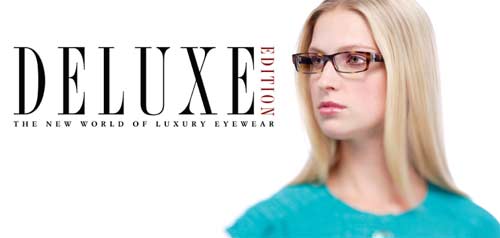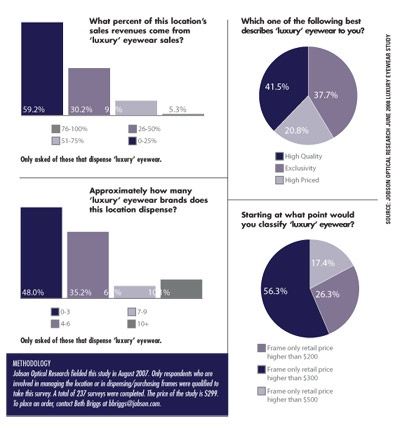
BLINDE Somewhat Sane BY RICHARD WALKER from Optical Shop of Aspen
Luxury eyewear is a critical niche in the optical market. It makes the wearer feel pampered and glamorous with its reputable name brands and high quality. Check out these findings from Jobson Optical Research to see how eyecare professionals view luxury.
—Melissa Arkin

Which of the following best describes ‘luxury’ eyewear to you?
When faced with the subject of luxury eyewear, respondents were asked to pick one qualifying feature that best defines eyewear to them. The number-one response (42 percent) ECPs selected was that “high quality” best described luxury eyewear. After that, “exclusivity” got 38 percent of the respondents’ votes, followed by 21 percent who thought a “high price” was the key factor in luxury eyewear.
Starting at which price point would you classify ‘luxury’ eyewear?
The majority (56 percent) of ECPs consider the retail price point at which a frame can be considered “luxury” to be higher than $300. More than one quarter (26 percent) responded that $200 was the price at which they’d refer to eyewear as luxury and only 17 percent said they’d call frames luxury if they cost over $500.
Approximately how many ‘luxury’ eyewear brands does your location dispense?
They say the more the merrier, but among the locations dispensing luxury eyewear, almost half (48 percent) keep it simple and carry three luxury brands or less and over one-third (35 percent) carry between four and six brands. A drastically smaller percentage (7 percent) carried between seven and nine luxury brands, while one-tenth (10 percent) carried 10 brands or more.
What percent of your location’s sales revenues come from ‘luxury’ eyewear sales?
For more than half of the ECPs questioned that dispense ‘luxury’ eyewear (59 percent), the percent of sales revenue coming from ‘luxury’ eyewear sales is under 25 percent. Almost one-third (30 percent) say between 26 to 50 percent of sales come from ‘luxury’ frames. Not many people reported that their ‘luxury’ eyewear sales constituted over half of frame sales, with only 10 percent selling between 51 and 75 percent, and only 1 percent comprising 76 to 100 percent of sales.











